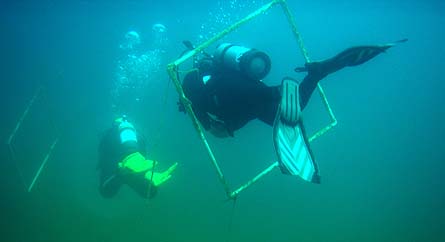« May 2008 | Main | July 2008 »
June 29, 2008
Full face mask and saltwater
Yesterday I got to experience a new piece of scuba equipment, a full-face mask - and also do my first dive in saltwater. Unfortunately, this all sounds much grander than it was. It all took place at a party at the wonderful home and pool of diving friends. One of the group had brought her full-face mask together with BC and a full tank of air so anyone could check it out. And the gorgeous pool was a saltwater pool, so at least technically I can now say I have been diving in salt water. I know the particulars of this initiation into salt water will only add to the teasing I must endure for having done all of my dives so far in sweet water.
Anyway, the full-face mask was interesting. I had always viewed them as professional equipment beyond the reach and realm of recreational diving. In the "masks" section of our scubadiverinfo.com website I described full-face masks as follows:
"Full face masks protect professional and advanced recreational divers in polluted water and from stings, also allow verbal communication, and alleviate cramps from having to bite on a mouthpiece for long periods of time. They are also warmer in very cold water, and the chance of the mask getting knocked off accidentally is much lower. Full face masks are also referred to as "Jack Browne" masks in recognition of the Desco engineer who came up with the protytpe design of a full face mask with an integrated air supply attachment."
In practice, the full-face mask first looks a bit intimidating. It's large and it has a fairly elaborate strap system. The second stage is built into the mask, so there is no separate mouthpiece. You don't bite on one either. You simply put the mask on, get your hair out of the way, and you're all set. You still breathe through your mouth. The nose is kind of blocked with a rubber piece. BC inflation works the same, with the usual up and down buttons and there was the usual backup second stage, though I am not sure how you'd use it with a full-face mask.
Go under and it's an entirely different experience.
The view is panoramic, and much more so than with any conventional mask I've tried, and by now I've tried quite a view different designs. I wish I could remember the make and model of the mask as, from the looks of it, not all full-face masks offer this panoramic view. As is, this one certainly stood out.
Breathing feels totally natural. It's through the mouth, but not having a mouthpiece to bite on is a huge advantage in my book. Most mouthpieces chafe on my gums or my jaw gets tired from the mouthpiece forever pulling this way or that.
Equalizing your ears is a bit different. The mask did not have the separate nosepiece I use to pinch my nose and blow against it to equalize. The advice was to either move your jaw from side to side or some variation of that, or to move the mask up to block the nose inside as it pushes against that rubber piece in the mask, and then blow against it. I can't remember exactly how I did it, but it was no big deal and certainly not a problem.
Since air flows inside the mask, there is no mask squeeze and you do never have to equalize pressure inside the mask. That's never been a problem for me, but some people forget to do it, sometimes with annoying consequences. All in all, not having to worry about it is nice.
Another big issue for me is mask fogging. I've tried just about every trick to keep my mask from fogging and it does it anyway. This is a real drag. I mean, you don't go diving to see a wondrous underwater world only to see it from behind a fogged-up mask. Sure, you can let some water in and swirl it around the lens occasionally, but that's hardly a satisfying solution. The full-face mask -- at least the one I tried -- did not fog up at all. I suppose it's because of the airflow. It's wonderful not to have to worry about that.
And then there is mask leaking. I was wondering how such a large mask would do. After all, the perimeter of the seal is a lot longer than that of a conventional mask. Amazingly, not as much as a single drop came in. Maybe that's again because of the positive air pressure. If the pressure inside and outside of the mask is the same, water won't come in.
As listed above, there are other reasons to wear a full-face mask. One is to be able to communicate with dive buddies who also wear a full face mask with communications gear, and with the surface. Since you don't have anything in your mouth you can talk, and an integrated microphone then picks it up. I didn't have the battery pack that powers the comms gear and so could not see how well it works.
As for the saltwater pool, it wasn't nearly as salty as I expected. It was also absolutely crystal clear and clean. I'll have to look into it for my own pool.
Posted by conradb212 at 4:38 PM
June 20, 2008
Quarry Diving
I finally got to dive again and this time it was in a quarry.
Quarries start out as open-pit mines where rocks and other materials are extracted. Once the quarry is no longer used it may fill with water and become a great place for diving. The place I went to is Loch Low-Minn near Athens, Tennessee, a 10-acre lake in the midst of 100 acres of wooded land. Check the web and you find it listed as a McMinn County Highway Department quarry that yielded crushed limestone for concrete and roads in the early 1960s. Its use as a scuba facility came about when a couple by the name of Rick and Stacy Low purchased the quarry in 1996. They named the place Loch (Scottish for Lake) Low (for their last name) Minn (for McMinn County). This quarry is quite popular and has been featured in Dive Training Magazine a couple of times. The owners live on site and take good care of the grounds and the facility. Unlike many quarries, this one has a good number of scuba-related attractions. There are two wooden diving platforms, floating gates for buoyancy training, a navigation course, and any number of sunken artifacts ranging from statues to a Lock Ness monster to funky items like a toilet and such. There is also a large diameter tube to swim through.

Depending on the water level, Loch Low Minn can be as deep as just over 80 feet at the center of the lake. I'd been told that visibility is quite good for a quarry, resulting from the three springs that seep into the lake and all the vegetation that filters run-off from around the lake.
We went there mid-week with a couple of students that had to complete their open water certification. The quarry owners were not there, but had left the big rolling entrance gate unlocked for us. The quarry itself is completely hidden. You don't see it until you drive over an incline and then there it is, a still body of water nestled into rocks and woods. There's a beach and a wooden deck with benches for divers to prepare. A bunch of catfish and a few bass swam around, obviously expecting to be fed.
It was quite hot and humid and I dreaded donning the wetsuit, but my new 7mm Scubapro went on a lot easier than my old 7mm Telos. For one thing, the Scubapro is a medium-long and a better fit than the medium Telos with its short arms and legs. For another, the Scubapro's material is stretchier and softer. It'd been a while since my last real dive and I didn't want to embarrass myself in front of two students, so I prepped my gear slowly and methodically, making sure I didn't forget anything or do anything stupid.
The water felt wonderful, with a surface temperature in the 70s. Carol spent some time talking to her students about the dives ahead and the tasks they had to complete: buoyancy control, emergency free ascents and diver rescue. Then we went down, heading for one of the diving platforms.
As almost always, I had a few minutes of nervousness. Visibility was somewhat less than I expected, and there were rather dramatic thermoclines. The quarry bottom slopes away steeply from the beach and so we soon found ourselves in fairly deep water. I saw the bottom below me disappear, making me feel as if I hovered over nothingness. Then we hit one of the thermoclines that gripped and chilled my body. There was a minute or two when I had to fight a sense of panic ('what if I something went wrong with me?' 'what if I faint?') that urged me to head for the surface. It was over soon and I felt okay again, but the thought of something happening while underwater is not pleasant and I hope I'll never find myself in such a situation.
We soon reached one of the platforms and Carol went through the checkout dive drills with her students. I had the Olympus 770 with me and took pictures of them. Then I saw some of the sunken artifacts I had been told about. I went exploring but the visibility was such that the dive platform quickly disappeared from view. I did not want to get separated from the group and returned before I completely lost sight of it.
Exercises done, we all resurfaced. Carol debriefed the guys and then we set course to the far end of the quarry where we hoped we'd spot some of paddlefish that had been released into the quarry a couple of years ago. This gave the guys an opportunity to learn about compass settings. When asked how they'd reverse the course once we were there, they promptly made the beginners' mistake of trying to visualize what was opposite the original compass reading instead of simply adding 180 degrees. That explained, off we went.

Even though there wasn't anyone else in the quarry to stir up silt, visibility remained fairly low and I realized the value of Carol's bright-yellow fins that made her harder to loose than had she worn standard black ones. As we approached the other end we began seeing slender horizontal shapes in the water -- paddlefish. They seem to be curious enough to check out divers but they don't come close, so I never saw one clear enough to take a picture. While Carol and the guys hovered to look at the paddlefish I decided to drop down to see where the bottom was but at around 40 feet it already got pretty cold dark and I lost sight of the group, and so I ascended until I was at their level again.
Carol then took the lead again and guided us close to the rock wall at the far end. For all practical purposes, it looked like a wall dive. It may have only gone down to 60 or 70 feet, but with the limited visibility it was easy to imagine being in a much larger setting. On we went and back into open water where we swam through a series of hovering PVC pipe shapes. It felt like being in a video game where you got points for flying through a series of gates. The shapes, of course, had been deployed to practice buoyancy. I had hoped we'd also be able to swim through the corrugated metal pipe laying near one of the diving platforms. I had seen it on video and felt it was a clever simulation of an overhead environment without actually being one, but it was on the other side of where we emerged and by now we were at the end of the checkout dives.

We checked remaining air with Carol, needless to say, having used barely more than half of us heavy breathers. Oh, this was also my first time on Nitrox. Since I hadn't brought any scuba gear except my trusted Scubapro Frameless mask I was using borrowed gear. The BC, fins and gauges all worked fine for me, except some chafing on my gums from the different second stage mouthpiece, but I was wondering whether I'd feel a difference diving 40% Nitrox. I didn't. A couple of times I felt a bit like one does after hyperventilating on purpose but I could be wrong. I felt no different after surfacing than I usually feel after a dive, but we'd never gone deeper than 40 feet and total dive time had been just under an hour, so I'll reserve judgement until a longer, deeper dive.
Diving the quarry was fun. It's a very peaceful place with nothing but nature. Before we left we fed the very tame catfish and the pesky bass that always darted between the catfish and snapped away the food from them. I want to go back and have some more time exploring the various stuff placed on the bottom, and also the rock wall on the far end. I am pretty sure I'll get a chance.
Posted by conradb212 at 2:37 PM








